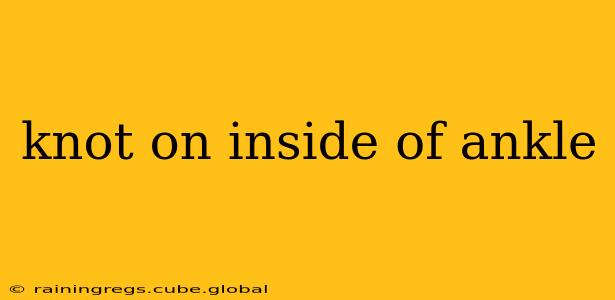A knot on the inside of your ankle can be a frustrating and painful experience. It can interfere with daily activities and sports, making it crucial to understand the potential causes and seek appropriate treatment. This comprehensive guide explores various reasons for ankle knots, offers advice on home remedies and professional medical care, and provides preventative measures to keep your ankles healthy.
What Could Be Causing a Knot on the Inside of My Ankle?
Several factors can contribute to the development of a knot-like sensation on the inside of your ankle. The specific cause will often dictate the best course of action.
1. Tendonitis:
Tendonitis, the inflammation of a tendon, is a common culprit. The tendons around your ankle, particularly the tibialis posterior tendon (responsible for supporting the arch of your foot), are frequently affected. Overuse, repetitive strain, or sudden injury can all trigger inflammation, leading to a palpable knot or thickening. This often presents with pain, swelling, and stiffness.
2. Ligament Sprains:
While typically associated with the outside of the ankle, ligament sprains on the inside (deltoid ligament) can also cause a knot-like feeling. These sprains often result from a forceful twisting or rolling of the ankle, leading to damage and inflammation of the ligaments. You may experience pain, swelling, and instability in your ankle joint.
3. Bursitis:
Bursae are small, fluid-filled sacs that cushion the joints. Inflammation of the bursae around the ankle (bursitis) can cause a lump or knot-like sensation. This inflammation is usually caused by overuse, repetitive motion, or direct injury to the area. Symptoms can include pain, swelling, and tenderness.
4. Ganglion Cysts:
These are benign, fluid-filled lumps that can develop near joints, including the ankle. They can present as a smooth, movable knot under the skin. While generally harmless, larger cysts can cause discomfort or pressure on nearby nerves or tendons.
5. Bone Spurs:
Osteophytes, or bone spurs, are bony growths that can develop on the bones of the ankle. They may not always cause symptoms, but if they press on surrounding tissues, they can lead to pain and a knot-like feeling.
6. Muscle Strains:
Strained muscles in the lower leg, such as the tibialis posterior muscle, can sometimes feel like a knot on the inside of the ankle. This usually involves pain, tightness, and reduced flexibility in the affected muscle.
How Do I Treat a Knot on the Inside of My Ankle?
Treatment depends heavily on the underlying cause. For minor issues, home management strategies may suffice. However, for persistent or severe pain, consulting a medical professional is essential.
Home Remedies:
- RICE method: Rest, Ice, Compression, and Elevation. This classic approach reduces swelling and inflammation.
- Over-the-counter pain relievers: Ibuprofen or naproxen can help manage pain and inflammation.
- Gentle stretching and exercises: Consult a physical therapist for tailored exercises to improve flexibility and strengthen the ankle. Avoid activities that aggravate the pain.
When Should I See a Doctor?
Seek medical attention if:
- The pain is severe or doesn't improve with home treatment.
- You have significant swelling or bruising.
- You experience instability or difficulty walking.
- You suspect a fracture or ligament tear.
- You notice a rapidly growing lump.
A doctor can accurately diagnose the cause of your ankle knot through a physical examination, imaging tests (X-rays, MRI), and potentially other diagnostic procedures. They can then recommend appropriate treatment, which may include physical therapy, medication, injections, or in rare cases, surgery.
How Can I Prevent Ankle Knots?
Prevention is key to maintaining healthy ankles. Consider these strategies:
- Proper footwear: Wear supportive shoes that fit well and provide adequate cushioning.
- Regular stretching and strengthening exercises: Improve ankle flexibility and strength to reduce the risk of injury.
- Warm-up before exercise: Prepare your muscles and joints before engaging in physical activity.
- Maintain a healthy weight: Excess weight puts extra stress on your ankles and joints.
- Proper training techniques: Avoid overuse and repetitive strain during exercise.
By understanding the potential causes, seeking appropriate medical care when needed, and implementing preventative measures, you can effectively manage ankle knots and maintain healthy, pain-free ankles. Remember, this information is for general knowledge and doesn't replace professional medical advice. Always consult a healthcare provider for diagnosis and treatment.
